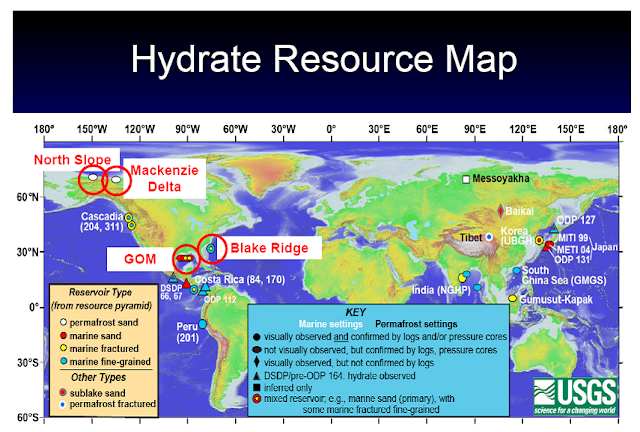Methane hydrates occur in polar permafrost regions and marine outer continental margins and represent a potentially enormous energy resource.
Hydrates are naturally occurring crystalline compounds of natural gas enclosed within a cage-like lattice of water ice. Chemists call such structures clathrates. In methane hydrates, water crystallizes in the cubic system, rather than in the hexagonal structure of normal ice. The resulting compound packs a lot of methane in its dense organization. One cubic foot of hydrate contains about 164 cubic feet of methane gas.With adequate gas concentrations, methane hydrates form and are stable under moderate- to high pressure, low temperature conditions. This Methane Hydrate Stability Zone (MHSZ) typically occurs: 1) on continental margins at water depths greater than about 300 m and bottom water temperatures close to 0° C, where gas hydrate is found from the sediment surface to depths of about
1100 m below the seafloor, and 2) in polar continental regions, where gas hydrate can be present in sediment and permafrost at depths between about 150 and 2000 m.Early estimates of the total resource were as speculative as they were impressive. Current work using geology-based Total Petroleum System (TPS) assessments still yields very large numbers.
The USGS recently estimated that there are about 85.4 trillion cubic feet (Tcf) of undiscovered, technically recoverable gas resources within methane hydrates in northern Alaska alone (Collett, 2009). The Minerals Management service conducted an evaluation of the petroleum system for the Gulf of Mexico and estimated a mean value of 21,444 Tcf with 6,717 Tcf in place in sandstone reservoirs
(Frye, 2008). Mean estimated resource of domestic methane hydrate in place is about 200,000 Tcf (NETL, site accessed 4/28/11).
Source
Two primary source mechanisms have been recognized based on carbon and hydrogen isotopic analysis (Uchida, et al, 2009): microbial decay of organic matter within the gas-hydrate stability zone and thermogenic methane. Thermogenic methane may migrate from thermally mature, deep-seated organic shales, or by leakage from deeper, conventional free gas reservoirs (Lorenson, 2011).
Reservoir
An important difference between methane hydrate accumulations and more conventional gas fields is the nature of the reservoir beds containing the gas: methane hydrate deposits occur in young, relatively unconsolidated sediments where the ice-like hydrate structure holds the gas in place. Methane hydrates occur within a range of reservoir facies, from mudstones to gravels. Sandy siliciclastic reservoirs are considered to be the most favorable for commercial exploitation.
Seal
The seal is provided by the clathrate structure itself. In fact, it is increasingly recognized that the hydrate accumulations may provide a top and lateral seal for deeper free-gas reservoirs outside the methane hydrate stability zone (MHSZ).
Trap
The trapping mechanism, too, is attributed to the arrangement of methane within the clathrate structure. As free gas migrates into the MHSZ, it is chemically trapped within the crystalline configuration of the naturally formed clathrate.
( from Search & Discovery #80193)


No comments:
Post a Comment